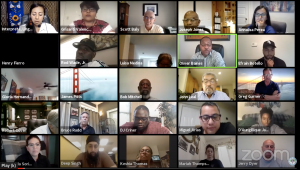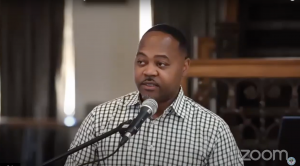FRESNO, Calif. — At 9 p.m. in late August the Fresno Police Reform Commission was four hours into its fourth general meeting when members began to debate whether school resource officers should wear polos instead of uniforms.
“We would like them to be in street clothes or their police polos, shorts, jeans. We don’t want them walking around in their combat uniform,” said Keshia Thomas, president of the Fresno Unified School District and one of the 37 members of the commission.
The debate over what police officers should wear in schools was among the more contentious topics. Discussions about the lack of diversity among Fresno PD officers, that police officers should not answer mental health calls and qualified immunity should end reached consensus.
The commission was established after Miguel Arias, Fresno City Council president, requested it in response to the local march of more than 3,000 Fresnans in a Black Lives Matter protest following the death of George Floyd, who was killed in Minneapolis police custody in May.

A screenshot of the virtual Fresno Police Reform Commission meeting on Aug. 24, 2020. (Screenshot provided by Maria Esquinca/GroundTruth)
“We felt it was important to actually follow through with a body of work that would improve policing in our city,” Arias said, recalling multiple cases involving the use of excessive force by police, resulting in deaths and which cost the city millions of dollars in settlements.
An analysis of officer-involved shootings in Fresno by the American Civil Liberties Union found significant racial differences in the number of local shootings. From 2006 to 2016, the Hispanic population represented 44% of the population and 58% of officer-involved shootings, while Black residents represented 8% of the city’s population but 22% of officer-involved shootings in that same period. By comparison, white residents, who comprised 29% of the population at the time, accounted for just 8% of officer-involved shootings.
The report also revealed that the largest percentage of officer-involved shootings occurred in south Fresno, an overwhelmingly Black, Latino and low-income part of the city.
“People in south Fresno have been over-policed, over-criminalized, and don’t have the same relationship and the same lived experience when it comes to public safety,” said Arias.
In 2017, Sgt. Ray Villalvazo shot 16-year-old Isiah Murrietta-Golding in the back of the head as Murrietta-Golding ran away from officers; video of the teen’s death galvanized the community. Even as residents and activists continue to demand for charges to be brought against Villalvazo, local protests after the death of George Floyd compelled the city’s leadership to form the Police Reform Commission.
“You have people there who want to defund a police department. You have the president of the police union who is steadfast in his support for his officers,” Arias said. He added that the members are “folks who are going to be committed to working through very difficult conversations.”
The diversity of the commission members — divided into four subcommittees: police budget, police tactics, community input and community development — has sometimes resulted in divisions, but Arias said the range of representation, from activists to police officers, was intentional.

“This was supposed to be the committee that’s far reaching,” said Oliver Baines, chair of the Fresno Police Reform Commission, describing the Community Development subcommittee during the Aug. 24 meeting. Baines is a former Fresno city council member and Fresno PD officer. (Screenshot by Maria Esquinca/GroundTruth)
“The commission’s work can only be as good as the commission is reflective of the city,” he said.
Now, they’re tasked with evaluating police practices and recommending changes to the city council, which will then consider adopting their suggestions as it begins budget meetings this fall.
But the divisive dress code recommendation, put forth by the community development subcommittee, illuminated some of the fundamental challenges the committee faces in finding a consensus.

“I don’t think that putting police officers in a dress code to make them appear more friendly, when they are literally trained to kill on command, is wise,” said D’Aungillique Jackson, president of the Fresno State NAACP and chair of the community input subcommittee.
Her response drew strong criticism from Sgt. Ron Manning, a Fresno police officer and a member of the commission. Manning, 51, was particularly perturbed by Jackson’s claim that school resource officers “terrorize” children.
“Telling the people that law enforcement is on campus to frighten students, to terrorize kids,” Manning responded, “I don’t know where that came from. I’ve never seen it.”
“Real life experience; it came from real life experience,” Jackson asserted.
Their exchange reflects the tensions of the national conversation around holding police departments to a higher level of scrutiny, discourse marked by mutual distrust and often disparate life experience. Attempts to follow-up with Manning were denied by Fresno PD’s public information officer, who referred any questions about the commission to the city council.
“To be in that commission meeting and to hear so much praise for this department as it stands — not so much praise for what the department could become — it was hard,” Jackson said later. “What we were doing in that moment was not reimagining, we were reestablishing what already exists.”
For members like Jackson, part of that reimagination means removing officers from schools.
Earlier forms of the school resource officer existed as early as the 1950s. But since the ’90s, they’ve had a growing presence, partly due to an increase in federal funding for community policing after Congress passed Title I of the Violent Crime Control and Law Enforcement Act, allocating nearly $9 billion over six years for the Community Oriented Policing Services Office to distribute.
A 2018 study by the Urban Institute found that 68% of American public high school students attend a school with a police officer. The study noted that, “research on the effects of police on student and school outcomes is limited, and the evidence that does exist is mixed.”
But opponents of school resource officers point to the disproportionate rates of policing experienced by brown and Black students. A U.S. Department of Education Office for Civil Rights report from 2014 found that while Black students represented 16% of student enrollment in 2014, they comprised 31% of school-related arrests. White students by comparison represented 51% of enrollment and 39% of arrests.
Ashley Rojas, executive director of Fresno Barrios Unidos and a member of the community development subcommittee, summarized the dress code recommendation outcome at the meeting: “We certainly didn’t have consensus.”
At a more recent Fresno Unified School District board meeting, however, 21 out of 23 public comments called for or suggested board members not to renew their school resource officer contract with Fresno PD.
For her part, Jackson says she’d wouldn’t change what she said to Manning, but she would change the way she went about her message because police reform is bigger than individual officers.
“He’s a phenomenal resource for so many Black youth,” she says. But “he is an individual. (He) is not the issue; it’s the system and the way it empowers.”
María Esquinca covers California’s Central Valley for Radio Bilingüe. This dispatch is part of a series called “On the Ground” with Report for America, an initiative of The GroundTruth Project. Follow her on Twitter: @m_esquinca.













